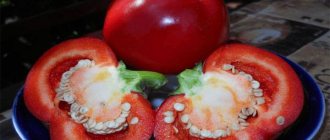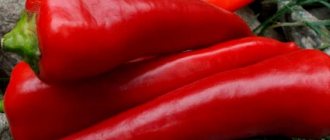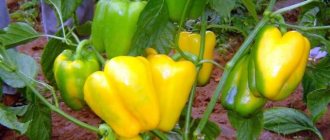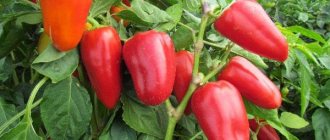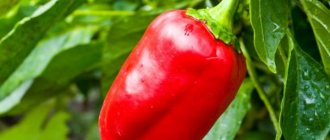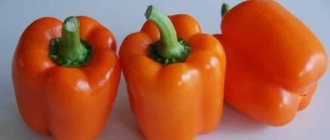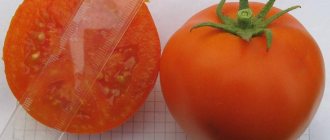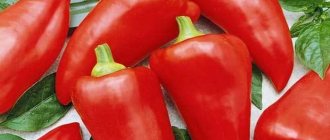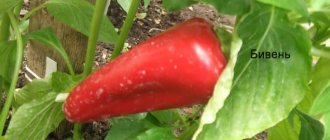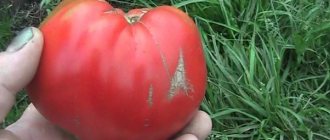General description of the variety
Jupiter F1 is the result of the work of Dutch agronomists from a Dutch seed organization called Syngenta seeds. It was first cultivated in the late 90s of the last century. The variety quickly spread throughout Europe and gained unprecedented popularity among amateur gardeners. In Russia, they learned about Jupiter only in 2003. The foreigner was not received as cordially as in his homeland. However, over the past 15 years, it has taken root well in our land and is loved by many gardeners.
As befits hybrids, Jupiter has many positive qualities that distinguish it from other varieties.
Description of the hybrid
Pepper Jupiter F1 is the brainchild of the famous seed company from the Netherlands, Syngenta seeds. This hybrid was obtained back in the late 90s of the last century. At the turn of the century, it appeared in Russia and already in 2003 it was officially registered in the State Register of Breeding Achievements of Russia for cultivation in open ground and under shelters in all regions of our country.
Therefore, Jupiter pepper will be a good choice for gardeners in the southern regions and for residents of the Urals and Siberia. True, the latter will need to either acquire a greenhouse, or at least build temporary shelters, covering them with film or any non-woven material.
Jupiter pepper plants are medium in height, about 50-60 cm they grow in open ground, in greenhouse conditions they can be a little larger. The bushes are characterized by a semi-spreading, semi-standard form. They have an interesting umbrella-shaped shape, with a small, barely noticeable depression in the center of the bush. The leaves are medium sized, dark green.
As for the timing of ripening, the Jupiter hybrid is a mid-season pepper. It needs 130-140 days from germination to the stage of technical maturity.
Carefully! In various descriptions of the seeds of this pepper hybrid, the figure of 75-80 days is often mentioned when talking about ripening time. Therefore, it seems that Jupiter pepper is an ultra-early ripening hybrid.
But only an attentive eye can notice that we are talking about the growing season from the moment the seedlings are planted in the ground. Pay attention to this, do not be misled. After all, seedlings are usually planted in the ground when they are at least 50-60 days old. Yes, and in such a short period of time it is simply impossible for peppers to form a real thick and juicy shell, which is distinguished by the Jupiter hybrid.
Pepper Jupiter F1 has good yield indicators: in open ground, up to 3 kg of fruit can be harvested from one square meter. In greenhouse conditions, the yield of peppers can increase to 4-4.5 kg per square meter.
Hybrid Jupiter is highly resistant to tobacco mosaic virus. It is also stress-resistant and can withstand various adverse weather conditions, especially hot weather.
Comment! The umbrella-shaped and well-leafed shape of the bush saves the fruits from sunburn in the heat.
The hybrid is also relatively drought-resistant.
Advantages of the variety:
- high quality fruits;
- large fruit size;
- rapid ripening;
- excellent taste;
- low price for seeds;
- resistant to all dangerous diseases;
- tolerates drought well;
- has excellent keeping quality and withstands transportation.
The Jupiter variety is good in every sense, with the exception of one feature inherent in all hybrid varieties: the seeds bear fruit only for one season.
Fact : collected hybrid seeds will not give the same yield and quality the next season. Therefore, it is advisable to buy new seeds in the store.
Reviews
Maria 50 years old Krasnodar region
I have been growing this variety for three years now, and have never regretted it. The fruits grow large and fleshy. They have excellent taste, sweet and juicy. The whole family loves him very much. I make preparations from it for the winter, I just chop it finely in the freezer so that I can add it to different dishes, and I freeze it entirely and then stuff it. It also makes very tasty lecho, thick and aromatic. And adjika is simply delicious! I recommend everyone who loves sweet peppers to grow this variety!
Anatoly 63 years old Taganrog
"Jupiter" is the most excellent variety that I have planted before. The fruits are sweet, fleshy, there is no bitterness at all. Gives a special taste to borscht and soups. My wife freezes it in the freezer for the winter and preserves it in tomato juice and slices. This is my second year planting and I plan to grow it next year.
Anastasia 30 years old Novocherkassk
My neighbor at the dacha treated me to several peppercorns, I really liked the taste, and decided to plant some for myself. The next season I bought seedlings, the harvest was simply magnificent, the fruits were beautiful. I am very pleased!
Characteristics of the variety
Jupiter belongs to the mid-early varieties. The growing season lasts 120-140 days (90 days pass from the moment the seedlings are planted to the technical ripening of the fruits).
Suitable for growing in greenhouse conditions and in open ground. Since pepper is a heat-loving plant and does not tolerate the vagaries of the weather, in the Northern regions and the middle zone it is better to grow it in greenhouses, while in the south it easily grows in street beds.
The pepper bush grows short, rarely reaching 80 centimeters. The plant has a lush crown, which well shades the ground under the stems, thereby protecting it from the sun and retaining moisture. In some cases, there is a need for tying.
The name “Jupiter” pepper was given for a reason: its fruits grow powerful, huge, amazing, just like the largest planet in the solar system. Cuboid peppers reach 15*15 centimeters in size and weigh on average 150-170 grams. The wall thickness sometimes reaches one centimeter.
The structure of the pepper fruit is dense, fleshy, with a high percentage of juiciness. The fruits taste very sweet; even when not fully ripe, they can be eaten. Pepper is good for making lecho and marinades, but it is better to enjoy its pleasant taste fresh.
At the stage of technical ripeness, peppers have a dark green color, which quickly changes to a shiny dark red color, moving into the stage of biological maturity.
Jupiter sells well, as its external characteristics attract buyers, and its excellent transportability plays into the hands of farmers. In addition, Jupiter is quite easy to grow, because it is able to withstand unfavorable weather conditions, and also has strong immunity to a number of diseases, in particular, it is rarely affected by the tobacco mosaic virus.
Jupiter pepper produces a decent harvest: 3-3.5 kilograms per square meter (5 kilograms when grown in a greenhouse), 45 tons per hectare. The variety is considered high-yielding.
Advantages and disadvantages
Pepper Jupiter F1 has an impressive list of advantages:
- The plant is not affected by several destructive viruses.
- The fruits withstand transportation without loss of attractiveness and taste.
- Pepper is used by chefs as a versatile vegetable.
- The variety is adapted to development during drought.
- The harvest can be stored for a long time.
- The unusual crown protects the pepper from intense solar influence.
Advice. To increase the shelf life, it is advisable to collect fruits before the stage of full ripeness.
The hybrid is not without some negative aspects:
- own seeds are not suitable for propagation;
- The yield in open ground is significantly inferior to that of greenhouse bushes.
Features of cultivation
Since it takes about four months for the fruits to fully ripen, it is better to sow the seeds as early as possible in order to get the harvest on time. It is most favorable to sow in February, although many summer residents, having been growing Jupiter for several years, recommend planting this variety in January. If you plant peppers so early, then in May the seedlings can be transferred to the greenhouse.
Since Jupiter seeds are always purchased, then, naturally, they have all already undergone high-quality selection and only the necessary material is collected in the bag, which most often has already been treated with a growth stimulant and disinfected with thiram. In this case, there is no need to further soak them and use various processing agents.
If the package does not say that the seeds have passed all the necessary procedures, then you need to do this yourself before sowing.
Seed preparation:
- Pour the seeds with a solution of 1 gram of potassium permanganate and 100 milliliters of water. This is how disinfection occurs.
- Next, treat the seeds with a growth stimulant to increase their productivity.
Seeds are usually sown in large boxes in pre-prepared soil. The soil should be warm, well fertilized (organic and mineral compounds), loose and moist. You can also disinfect the soil: water the soil with a solution of manganese.
Soil composition:
- humus (2 parts);
- coarse river sand (1 part);
- land from the site (1 part);
- wood ash (2 tbsp.).
Important: the Jupiter variety has a weak and poorly developed root system. To avoid further injury to the rhizome, it is recommended to sow the seeds in special peat tablets or cups. Subsequently, the seedlings are planted in the ground directly in them, so the need to pull young plants out of the ground will disappear by itself.
Treated seeds germinate very well in most cases. Gardeners note almost one hundred percent germination of seed material of this variety. In order for the seeds to set faster and seedlings to appear faster, the boxes or containers in which the pepper grows need to be covered with film and provided with an abundance of sunlight. Since the days are still short at the end of winter and early spring, this is not enough for the formation of strong and healthy shoots. Therefore, fluorescent lamps are used as the sun, which are installed directly above the seedlings. At first, peppers require up to 18 hours of light daily. The air temperature is at least 25 degrees. When the seedlings rise a little, the duration of illumination is reduced and the film is removed.
If the pepper grew in common soil, then with the appearance of two or three leaves it will need to be plucked. Transplanting seedlings into separate containers should be done very carefully so as not to injure the roots. At first, the young bushes will hurt, but after three to four days they will get stronger.
Features of agricultural technology
Pepper should be propagated by seedlings. The principles of planting and caring for crops are as follows:
- the seeds do not need to be pre-treated, but germination measures are necessary;
- sowing is carried out from February, so the seedlings need to extend the daylight time to 12 hours with the help of artificial lighting;
- seedlings will be stronger if they are grown immediately in separate containers;
- the transfer of bushes to the beds is carried out after 2 - 2.5 months from the moment of emergence;
- water the pepper approximately every 4 days;
- Fertilize the crop according to the classical scheme: 14 days after planting, during flowering, during active crop formation.
Sowing seeds for seedlings | Planting seedlings in a greenhouse/greenhouse | Planting seedlings in exhaust gas | Stepsoning | Harvesting |
| February | May | The beginning of June | Until the first fork | From August |
| *dates are indicated for central Russia | ||||
Landing in the ground
Jupiter seedlings are transferred to outdoor growth two to two and a half months after sowing the seeds. This usually happens at the end of May, when really warm and sunny weather sets in. There is no need to rush into planting peppers, as any drop in temperature can cause illness or slow growth of peppers.
Further, until full ripening, it will take another two months, approximately the same amount of time this mid-early variety needs for the fruits to fill with juice, the crust to become hard and thick, and the taste to be enriched.
Proper planting of seedlings and their placement in the garden bed is the key to the healthy growth of strong bushes. The pepper bed is prepared in advance by adding fertilizers to the soil, which will facilitate the rapid development of roots in new conditions. Each pepper bush is planted in a separate hole, into which a complex mineral fertilizer consisting of potassium, phosphorus and nitrogen is placed in advance.
Important: nitrogen fertilizers are needed at the initial stage of growing this crop. It promotes rapid growth of stems and leaves.
The seedlings are not buried deeply, a sufficient depth of up to three centimeters is required, the rhizome must remain close to the surface, otherwise the roots will begin to grow in breadth and will be overgrown with additional shoots that will take away nutrition and moisture to the detriment of fruit formation.
There should be at least 30 centimeters between the bushes so that their rhizomes do not grow together, and each bush receives the portion of nutrients, sun and water it needs. Leave 45-50 centimeters between rows.
Even if peppers are planted in open ground at the beginning of June, it will not be a bad idea to initially protect them from the night cool with the help of temporary shelter. You can build a small greenhouse or cover the bushes with film, as you like.
If the plants grow in an open garden bed, then you should not form bushes. It is better to let the bushes grow large so that the dense foliage saves the pepper from overheating.
Fact: the more leaves there are on the plants, the more shoots will be formed, and accordingly the harvest will be higher.
Growing and caring for the plant
Hybrid pepper "Jupiter" is a resistant plant, but it also requires care throughout the entire growth cycle and fruit ripening.
- It is necessary to sow seeds for seedlings no later than February-March, since the variety is a mid-early variety. In this case, the seedlings will be ready for planting in May or early June.
- After 60-65 days from the moment of sowing the seeds, the sprouts can already be transplanted into open ground or a greenhouse. When planting in open ground in May, cover the plants with agrofibre so that a sufficiently low temperature at night does not destroy the pepper. You can also build a small portable greenhouse, which will be used until the air temperature reaches optimal o class=”aligncenter” width=”465″ height=”349″[/img]
- Pepper is a heat-loving plant. It is best to water the seedlings in the morning; the water should be warm, but not hot. Plants need to be fertilized with phosphorus and potassium supplements so that they gain strength for fruiting.
- If yellow or dry sheets appear, you need to tear them off. This may be a manifestation of a lack of various microelements in the soil, the influence of weather conditions, or disease.
- Peppers are a moisture-loving plant, so in hot weather you need to water them more often.
Advice! To keep the root system strong, constantly loosen the soil.
Features of care
To ensure a large pepper harvest, the bushes should be cared for using various processing techniques. In response to attentive care, he will give a generous harvest.
Tips for caring for Jupiter pepper:
- The soil under the bushes should be loose, so after planting you should not trample the ground. In a sweaty environment, diseases such as blackleg or even elephant foot can develop.
- Although the variety is drought-resistant, you should not leave peppers without water for a long time, otherwise it will cost you a large part of the harvest. Bushes especially need moisture during their intensive growth. It is worth watering the beds 3-4 times a week. Up to three liters of water should be poured onto each bush.
- Loosening the soil around the bushes helps the soil to better transmit water and air - the two main components for growth.
- In order for moisture to remain in the soil for a long time, you need to mulch the ground under the bushes. Sawdust or leaves are usually used as mulch. In addition, this method perfectly protects the roots from overheating during the summer heat.
- Peppers require two feedings per season. The first portion of fertilizer is applied a few days after planting the seedlings. A second feeding is needed during fruit formation.
Important! Potassium sulfide together with superphosphate perfectly stimulates the appearance of ovaries.
Pepper Jupiter: description of the variety, yield, growing characteristics
Pepper "Jupiter" is a hybrid variety. Dutch breeders bred the plant back in the 90s. For more than a decade, it has pleased agronomists who grow this variety in their beds with high yields.
Characteristics of "Jupiter" pepper
The “Jupiter” variety can be planted in open ground and in greenhouses. Feels great in various climatic conditions, but in harsh climates, it is recommended to grow in greenhouses. The yield per square meter with a 40×50 planting scheme is up to 4 kilograms.
The plant is semi-standard, that is, it looks like a small tree. The height of the pepper reaches 50-60 cm. The leaves at the top are bright green, closer to the ground they are dark green. The stem is massive, stable, erect. The fruits are cube-shaped with characteristic bulges near the tail and at the end of the pepper. During formation, the fruits are dark green, the mature vegetable acquires a bright red color. The weight of one pepper reaches 120-140 grams. The wall thickness is on average from 5 to 10 mm.
The variety "Jupiter" is part of the group of sweet peppers. There is no bitterness even in the veins connecting the seed part with the walls of the vegetable. Purposes include:
- canning in various ways (preparing lecho, canning in slices, salting, preparing adjika);
- adding fresh fruit to cooking;
- fresh consumption.
Advantages and disadvantages of pepper
- resistance to tobacco and potato mosaic diseases;
- high-yielding;
- flameproof;
- The fruits are massive, juicy and sweet.
The disadvantage is that it is impossible to obtain the same yield from collected hybrid seeds as from store-bought seeds.
Growing and caring for the plant
Hybrid pepper "Jupiter" is a resistant plant, but it also requires care throughout the entire growth cycle and fruit ripening.
- It is necessary to sow seeds for seedlings no later than February-March, since the variety is a mid-early variety. In this case, the seedlings will be ready for planting in May or early June.
- After 60-65 days from the moment of sowing the seeds, the sprouts can already be transplanted into open ground or a greenhouse. When planting in open ground in May, cover the plants with agrofibre so that a sufficiently low temperature at night does not destroy the pepper. You can also build a small portable greenhouse, which will be used until the air temperature reaches optimal o class=”aligncenter” width=”465″ height=”349″[/img]
- Pepper is a heat-loving plant. It is best to water the seedlings in the morning; the water should be warm, but not hot. Plants need to be fertilized with phosphorus and potassium supplements so that they gain strength for fruiting.
- If yellow or dry sheets appear, you need to tear them off. This may be a manifestation of a lack of various microelements in the soil, the influence of weather conditions, or disease.
- Peppers are a moisture-loving plant, so in hot weather you need to water them more often.
Reviews
I have been growing Jupiter peppers for three years. In all three years he has never disappointed. Its fruits are large, fleshy and very juicy. Pepper bushes are small and neat. In appearance, the plants look like small ornamental trees. In the third year, I planted 40 bushes that I even had to distribute the fruits to my relatives. They really liked the pepper too. The entire cellar is literally littered with various preserves. I like to freeze it in the freezer so that later in the winter I can prepare various dishes with fresh vegetables. I recommend trying the “Jupiter” variety to all sweet pepper lovers.
The “Jupiter” variety turned out to be the best among all the sweet peppers that I had grown previously. The fruits are large and satisfying, without bitterness, even at the contact of the walls with the seeds. It is pleasant to eat pepper both fresh and when adding it to various dishes. I use sweet fruits for preservation. I salt them in slices and prepare all sorts of sauces. Caring for the plants was not difficult. As agricultural experts advise, I watered them a lot and often loosened the soil. Once my husband treated the plants against aphids and the Colorado potato beetle. I am going to continue to plant Jupiter peppers in my garden.
Pepper "Jupiter" conquers with its ease of cultivation and wonderful taste of the fruit. Fans of sweet peppers will definitely love it.
Diseases and pests
This variety is rarely infected with any diseases. It is resistant to diseases such as:
- tobacco mosaic virus;
- potato virus Y;
- fungal and bacterial infections.
If the bushes are attacked by insect pests, then the pepper bed is treated with disinfecting fungicides. Keltan insecticides help well, or you can also sprinkle the bushes with ash - pests cannot tolerate it.
Advice: to avoid the development of various fungal diseases transmitted through the soil, you need to follow the rules of crop rotation and do not plant peppers in places where potatoes, eggplants and other pepper varieties previously grew.
Harvesting
Peppers are harvested from July to September. You can pick fruits that are in the technical stage of ripeness. However, they taste just as juicy and sweet. They ripen quickly without spoiling. If you pick peppers that are still green from the bush, the plant will have more strength to produce new fruits. This way you will increase your harvest.
Peppers store well in a cool, dark place.
Tip: to make the peppers ripen faster, add already ripe fruit to them. He will “distribute” his maturity to his neighbors.
Characteristics of "Jupiter" pepper
The “Jupiter” variety can be planted in open ground and in greenhouses. Feels great in various climatic conditions, but in harsh climates, it is recommended to grow in greenhouses. The yield per square meter with a 40×50 planting scheme is up to 4 kilograms.
The plant is semi-standard, that is, it looks like a small tree. The height of the pepper reaches 50-60 cm. The leaves at the top are bright green, closer to the ground they are dark green. The stem is massive, stable, erect. The fruits are cube-shaped with characteristic bulges near the tail and at the end of the pepper. During formation, the fruits are dark green, the mature vegetable acquires a bright red color. The weight of one pepper reaches 120-140 grams. The wall thickness is on average from 5 to 10 mm.
The variety "Jupiter" is part of the group of sweet peppers. There is no bitterness even in the veins connecting the seed part with the walls of the vegetable. Purposes include:
- canning in various ways (preparing lecho, canning in slices, salting, preparing adjika);
- adding fresh fruit to cooking;
- fresh consumption.
Advantages and disadvantages of pepper
- resistance to tobacco and potato mosaic diseases;
- high-yielding;
- flameproof;
- The fruits are massive, juicy and sweet.
The disadvantage is that it is impossible to obtain the same yield from collected hybrid seeds as from store-bought seeds.
